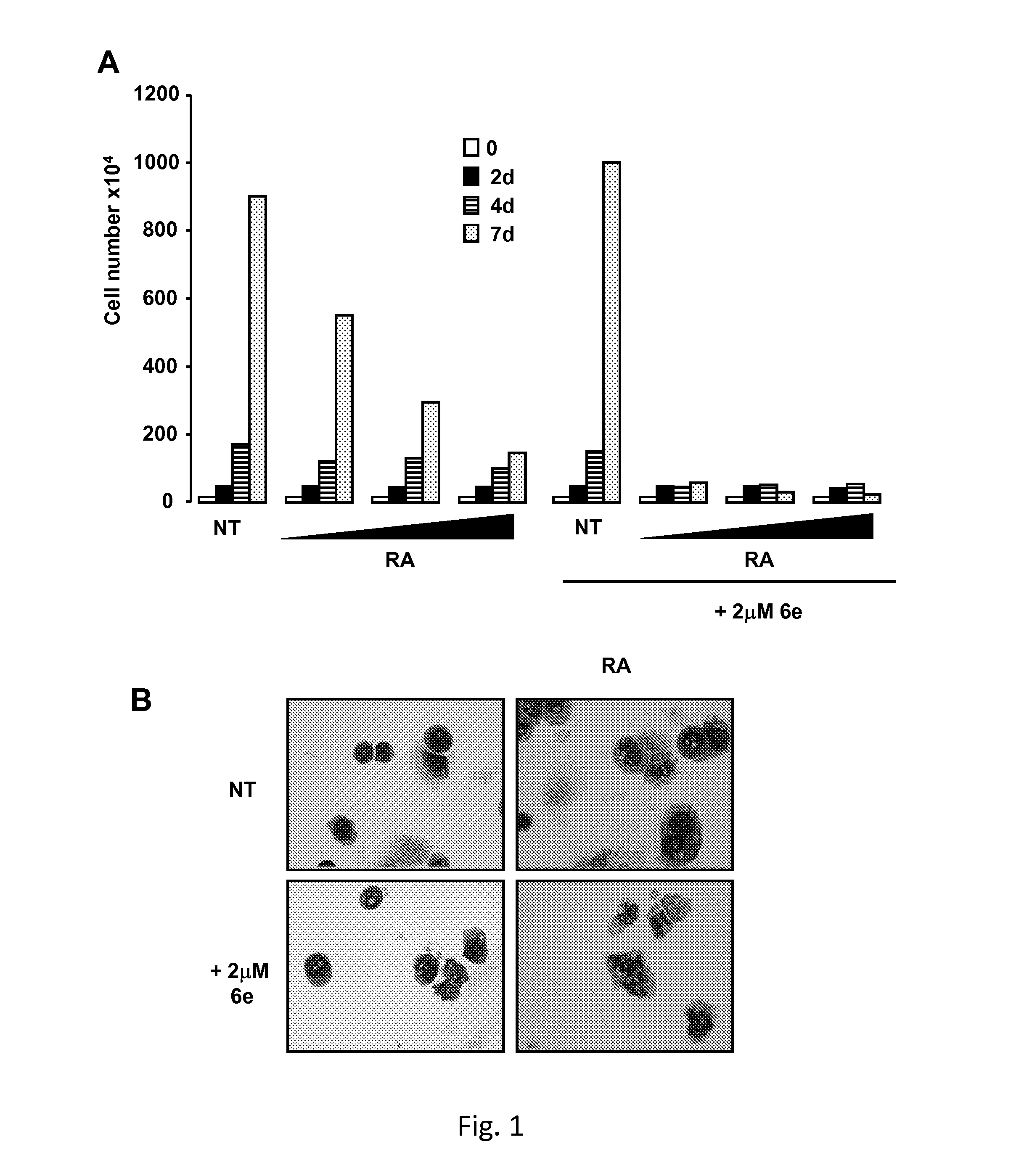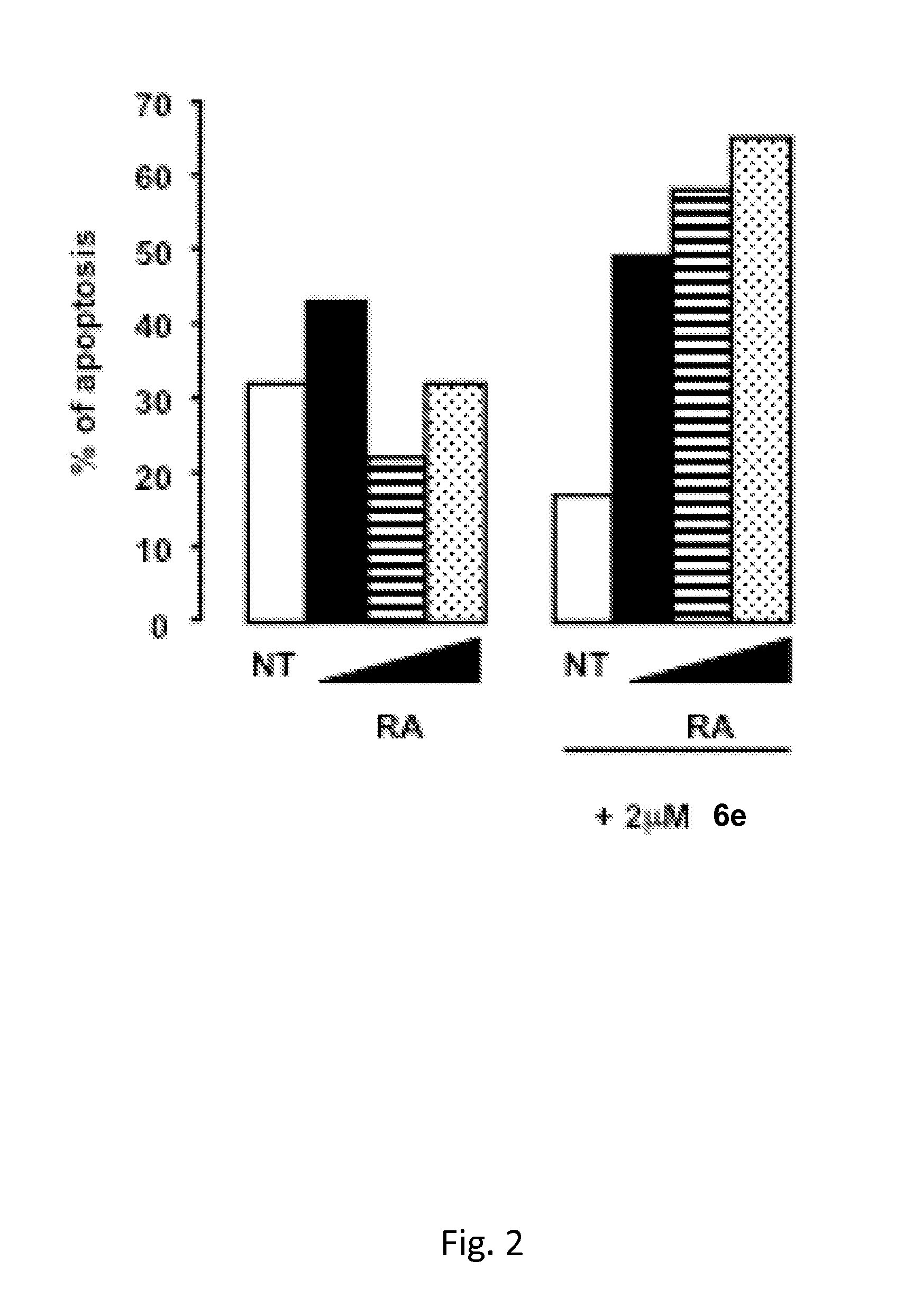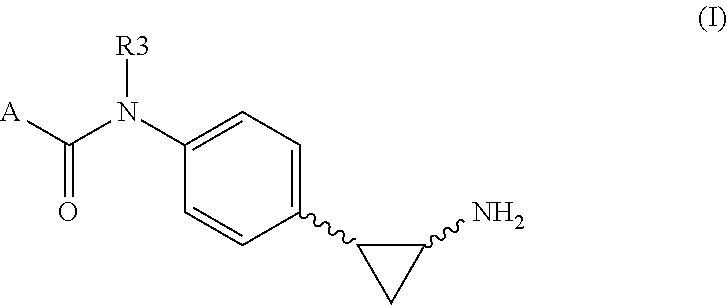Tranylcypromine derivatives as inhibitors of histone demethylases lsd1 and/or lsd2
a technology of histone demethylase and derivatives, which is applied in the direction of heterocyclic compound active ingredients, biocide, drug compositions, etc., can solve the problem of enzyms acting on a trimethylated lysin
- Summary
- Abstract
- Description
- Claims
- Application Information
AI Technical Summary
Benefits of technology
Problems solved by technology
Method used
Image
Examples
example 1
Preparation of trans and cis tert-Butyl 2-(4-Nitrophenyl)cyclopropyl Carbamates: trans tert-Butyl 2-(4-Nitrophenyl)cyclopropyl Carbamate
[0131]
[0132]A solution of trans 2-(4-nitrophenyl)cyclopropyl-1-carboxylic acid (5.3 mmol, 1.1 g) in dry benzene (20 mL), triethylamine (6.4 mmol, 0.9 mL), diphenylphosphoryl azide (5.8 mmol; 1.2 mL) and tert-butanol (53 mmol, 5 mL) was stirred at 80° C. under N2 atmosphere for 16 h. Afterwards, di-tert-butyldicarbonate (8 mmol, 1.7 g) was added, and the reaction was stirred at 80° C. for further 2 h. The solvent was removed under vacuum and the residue was chromatographed by silica gel eluting with ethyl acetate / n-hexane 1 / 3 to isolate the pure trans tert-butyl 2-(4-nitrophenyl)cyclopropyl carbamate as a pale yellow solid. 1H NMR (CDCl3, 400 MHz, δ; ppm) δ 1.29-1.33 (m, 2H, CH2 cyclopropane), 1.46 (s, 9H, C(CH3)3), 2.15-2.17 (m, 1H, PhCH), 2.80-2.82 (m, 1H, CHNH), 4.93 (bs, 1H, NHCO), 7.26-7.28 (d, 2H, aromatic protons), 8.13-8.15 (d, 2H, aromatic p...
example 2
Preparation of trans and cis tert-Butyl 2-(4-Aminophenyl)cyclopropyl Carbamates: trans tert-Butyl 2-(4-Aminophenyl)cyclopropyl Carbamate
[0133]
[0134]A mixture of trans tert-butyl 2-(4-nitrophenyl)cyclopropyl carbamate (2.88 mmol; 0.8 g), potassium carbonate (2.04 mmol; 0.28 g), 10% palladium on carbon (0.016 g) in tetrahydrofuran (3.88 mL) and water (3.8 mL) was degassed for 5 min, then a sodium hypophosphite solution (10.96 mmol, 1.16 g) in water (2.32 mL) was added dropwise under vigorous stirring. The resulting mixture was stirred at 60° C. for 5 h. The solvent was removed and the residue poured in water (100 mL) and extracted with diethyl ether (3×50 mL). The organic layers were washed with saturated sodium chloride solution (3×50 mL), dried with anhydrous sodium sulfate and concentrated. The residue was chromatographed on silica gel eluting with ethyl acetate / n-hexane 1 / 2 to afford tert-butyl 1-(4-aminophenyl)propan-2-yl carbamate as first eluate followed by trans tert-butyl 2-(...
example 3
Preparation of trans tert-butyl 2-(4-aroyl (or arylacetyl or benzyloxycarbonyl)aminophenyl)cyclopropyl carbamates (1a-h)
[0136]
trans tert-butyl 2-(4-benzoylaminophenyl)cyclopropyl carbamate (1b)
[0137]
[0138]Triethylamine (0.72 mmol, 0.1 mL) and benzoyl chloride (0.6 mmol, 0.09 mL) were added dropwise, with ice-bath external cooling, to a solution of trans tert-butyl 2-(4-aminophenyl)cyclopropyl carbamate (0.6 mmol, 0.150 g) in dry dichloromethane (5 mL). The resulting mixture was stirred for 1 h, then water (50 mL) was added, the organic layer was separated and the aqueous layer extracted with dichloromethane (2×30 mL). The organic phase was washed with saturated sodium chloride solution (3×50 mL), dried with anhydrous sodium sulfate and concentrated. The residue was purified by chromatographic column on silica gel eluting with ethyl acetate / n-hexane 1 / 3 to obtain pure compound lb as a white solid.
[0139]1H NMR (CDCl3, 400 MHz, δ; ppm) δ 1.12-1.15 (m, 2H, CH2 cyclopropane), 1.47 (s, 9H...
PUM
| Property | Measurement | Unit |
|---|---|---|
| temperature | aaaaa | aaaaa |
| pH | aaaaa | aaaaa |
| pH | aaaaa | aaaaa |
Abstract
Description
Claims
Application Information
 Login to View More
Login to View More - R&D
- Intellectual Property
- Life Sciences
- Materials
- Tech Scout
- Unparalleled Data Quality
- Higher Quality Content
- 60% Fewer Hallucinations
Browse by: Latest US Patents, China's latest patents, Technical Efficacy Thesaurus, Application Domain, Technology Topic, Popular Technical Reports.
© 2025 PatSnap. All rights reserved.Legal|Privacy policy|Modern Slavery Act Transparency Statement|Sitemap|About US| Contact US: help@patsnap.com



